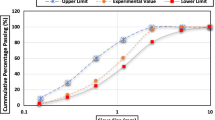Abstract
The moisture sorption characteristics of polymer concrete and its components (polyester resin, unfilled and filled with diabase flour) on long-term (up to 15-year) exposure to water at different temperatures are studied. It is established that, during the long-term sorption and subsequent desorption at 20°C, the ratio of diffusion coefficients of the polymer concrete and the corresponding resin is equal to the value of time-moisture reduction function, which characterizes changes in the creep compliance of the materials. The evaluation of the diffusion coefficient of the composite from the properties of its components, by using various known heat-and-mass-transfer models, shows that most acceptable is the Kerner model. With account of volume content of pores, an estimate for the limiting moisture content in the composite is proposed. An analysis of sorption curves of the composite and the corresponding resin reveals that Fick's law does not describe the experimental results in the range of large times and/or elevated temperatures. In the case of polyester resin filled with diabase flour, the “composite effect” is expressed in a linear increase in the specimen mass (the rate of the increase is temperature-dependent. In the case of polymer concrete, the “composite effect” is expressed in mass losses, which can be described by Fick's law with a diffusion coefficient and a limiting moisture content both depending on temperature.
Similar content being viewed by others
REFERENCES
K. Aniskevich, J. Hristova, and J. Jansons, “Deformational properties of polymer concrete during long-term exposure to water,” Mech. Compos. Mater., 39, No. 2, 111–119 (2003).
Y. J. Weitsman, “Composites in the sea: sorption, strength and fatigue,” in: Proc. 12th Int. Conf. Compos. Mater. (ICCM/12), June, Paris (1999).
N. E. Marcovich, M. M. Reboredo, and M. I. Aranguren, “Moisture diffusion in polyester-woodflour composites,” Polymer, 40, 7313–7320 (1999).
A. Apicella, C. Migliaresi, and L. Nicodemo, “Water sorption and mechanical properties of glass reinforced polyester resin,” Composites, 13, 406–407 (1982).
O. A. Plushchik and A. N. Aniskevich, “Water sorption and swelling of polyester resin,” Mater. Tekhnol. Instrum., 6, 49–53 (2001).
J. W. Chin, T. Nguyen, and K. Aouadi, “Sorption and diffusion of water, salt-water, and concrete pore solution in composite matrices,” J. Appl. Polym. Sci., 71, 483–492 (1999).
S. Marais, M. Metayer, M. Labbe, M. T. Legras, and J. M. Saiter, “Water diffusion in unsaturated polyester films. Effect of plasticization on the glass-transition,” Polym. Eng. Sci., 39, 1508–1516 (1999).
E. P. Gellert and D. M. Turley, “Seawater immersion aging of glass-fiber-reinforced polymer laminates for marine applications,” Composites. Pt. A. Appl. Sci. Manufact., 30, 1259–1265 (1999).
V. F. Janas and R. L. McCullough, “Moisture absorption in unfilled and glass-filled cross-linked polyester,” Compos. Sci. Technol., 29, 293–315 (1987).
R. D. Stepanov and O. F. Shlenskii, Calculation of Strength of Plastic Structures Operating in Liquid Media [in Russian], Mashinostroenie, Moscow (1981).
A. A. Tager, Physical Chemistry of Polymers [in Russian], Khimiya, Moscow (1978).
J. D. Ferry, Viscoelastic Properties of Polymers, John Wiley & Sons, New York (1970).
L. E. Nielsen, “Models for the permeability of filled polymer systems,” J. Macromol. Sci. Chem., 5, 929–942 (1967).
R. L. McCullough, “Generalized combining rules for predicting transport properties of composite materials,” Compos. Sci. Technol., 22, 3 (1985).
J. A. Manson and L. H. Spearling, Polymer Blends and Composites, Ch. 12, Premium Press, New York (1981).
H. Ziebland, “The thermal and electrical transmission properties of polymer composites,” in: M. O. W. Richardson (ed.), Polymer Engineering Composites, Ch. 7, Applied Science, London (1997).
R. H. Perry and C. H. Chilton, Chemical Engineer's Handbook, Ch. 3, McGrow-Hill—Kogakusha (1973).
Author information
Authors and Affiliations
Rights and permissions
About this article
Cite this article
Aniskevich, K., Hristova, J. & Jansons, J. Sorption Characteristics of Polymer Concrete during Long-Term Exposure to Water. Mechanics of Composite Materials 39, 305–314 (2003). https://doi.org/10.1023/A:1025690327033
Issue Date:
DOI: https://doi.org/10.1023/A:1025690327033




